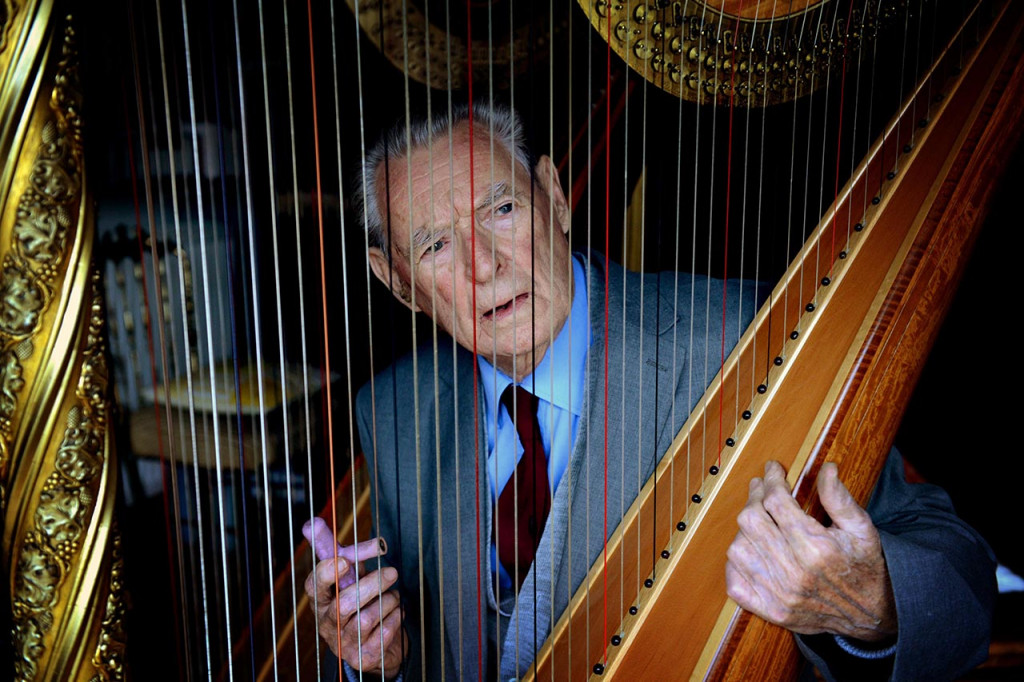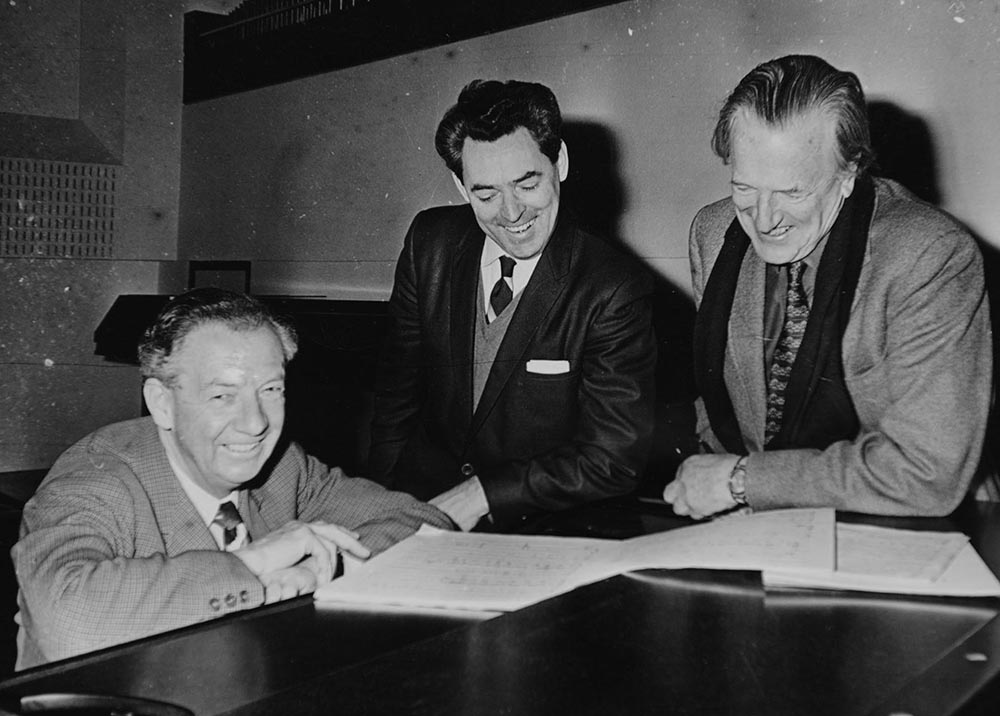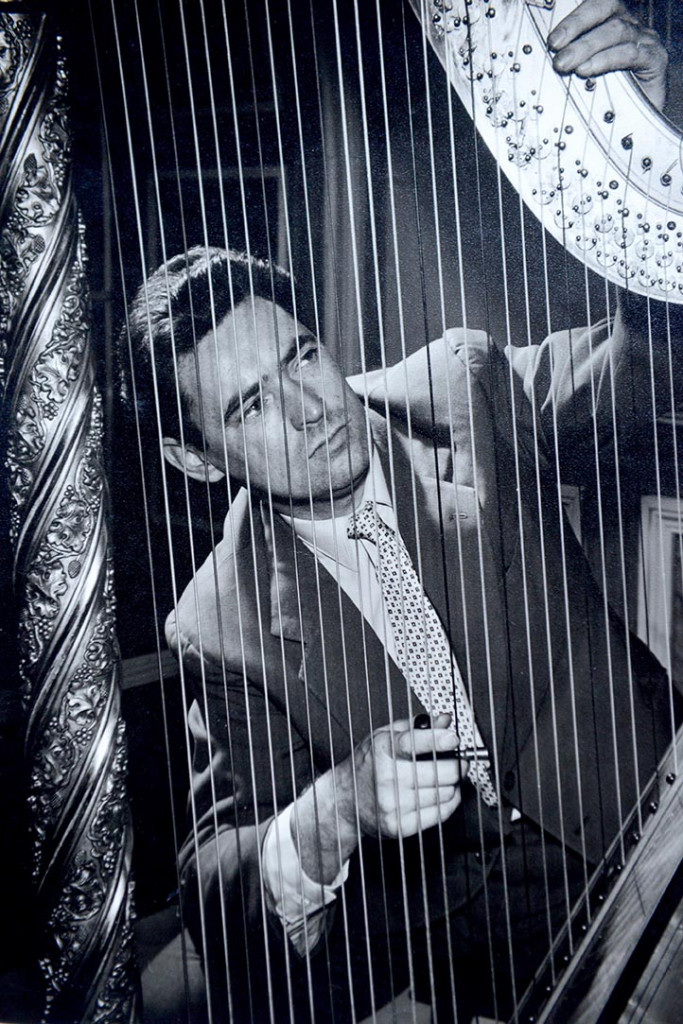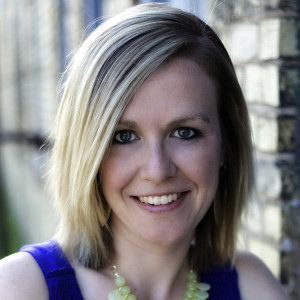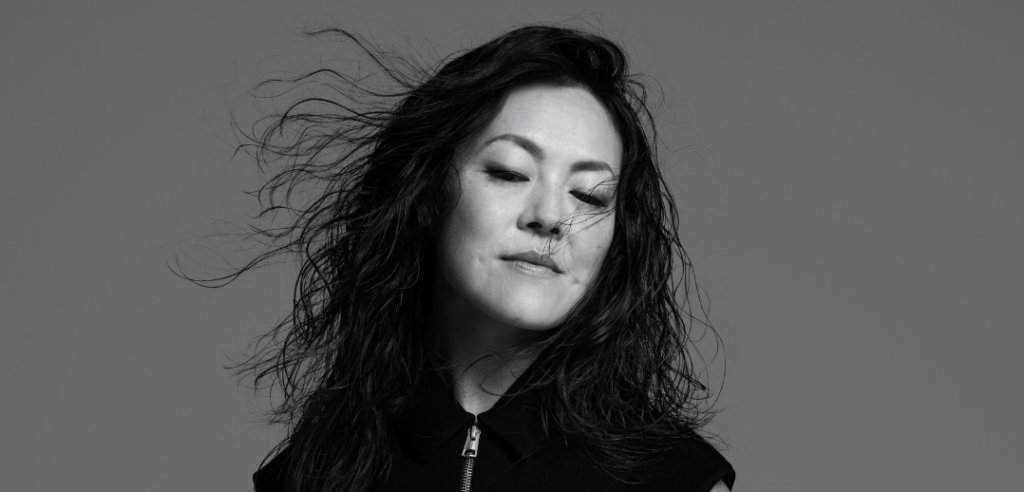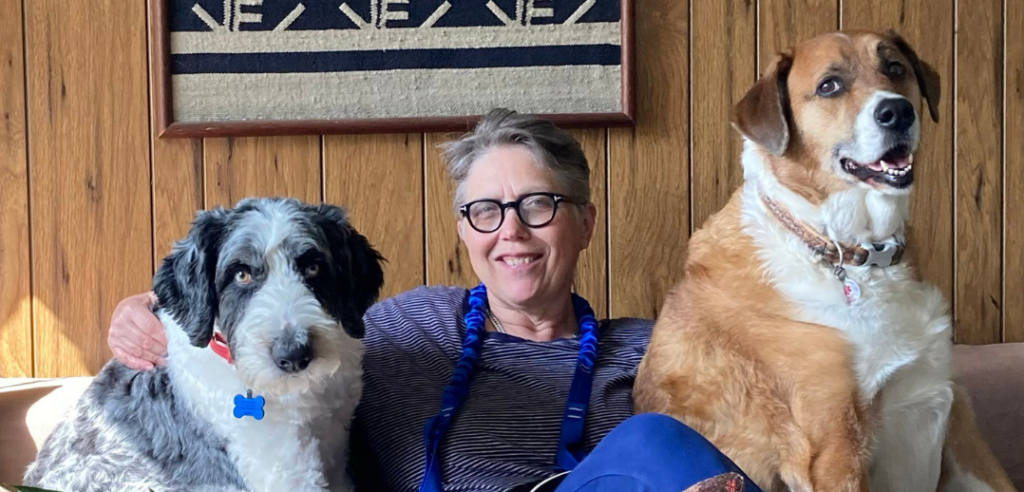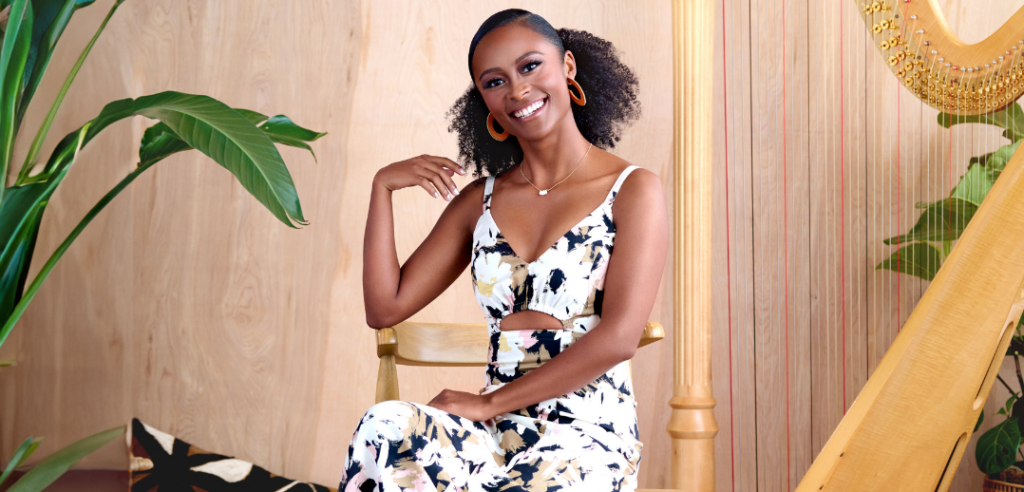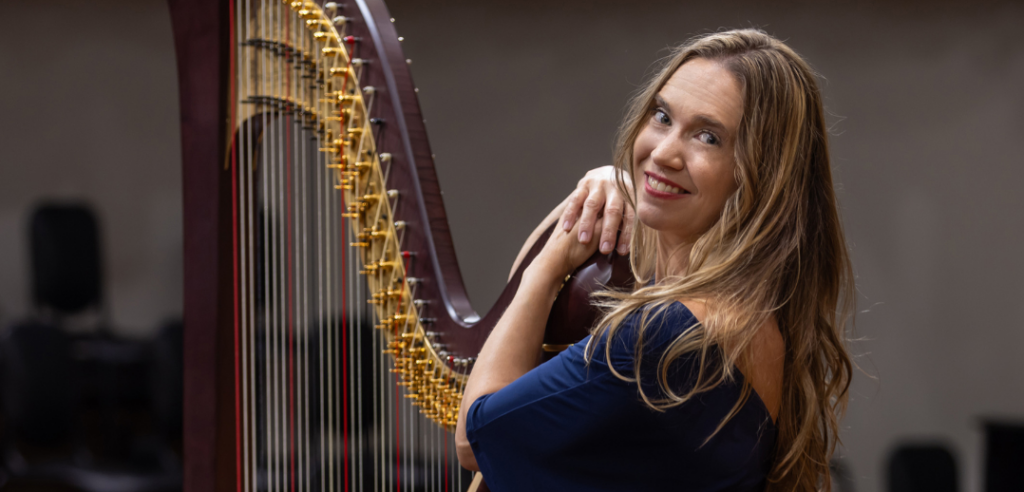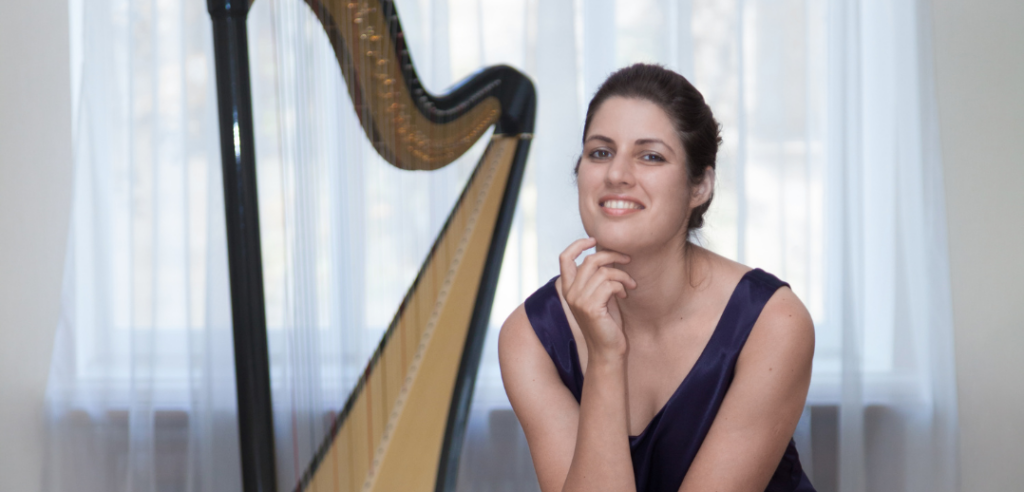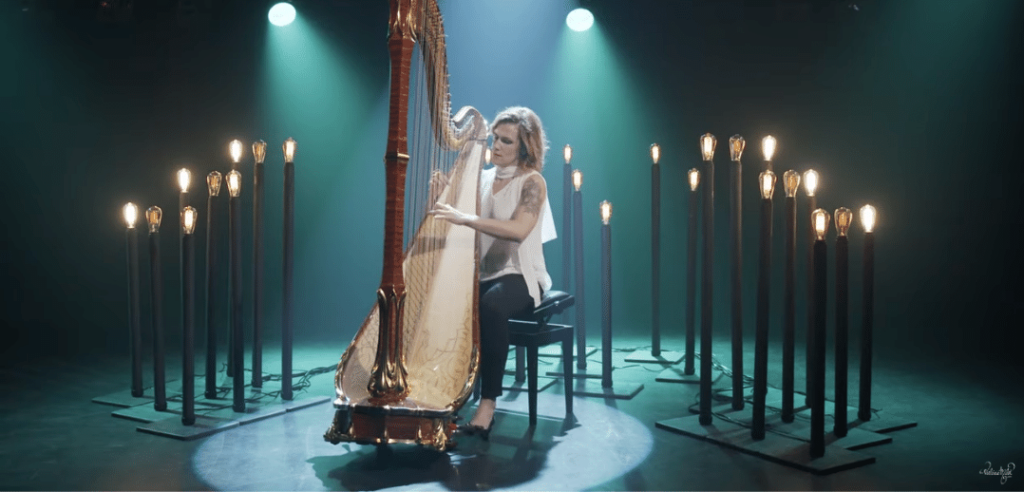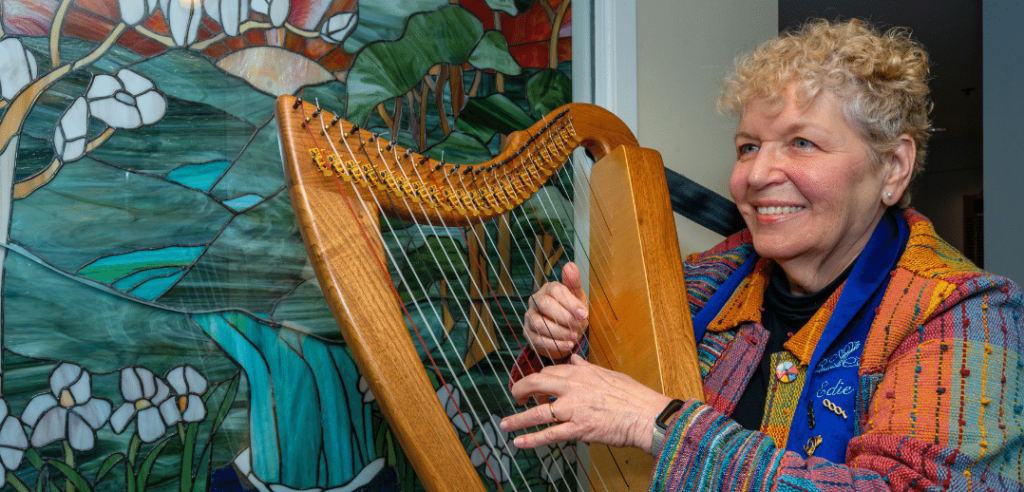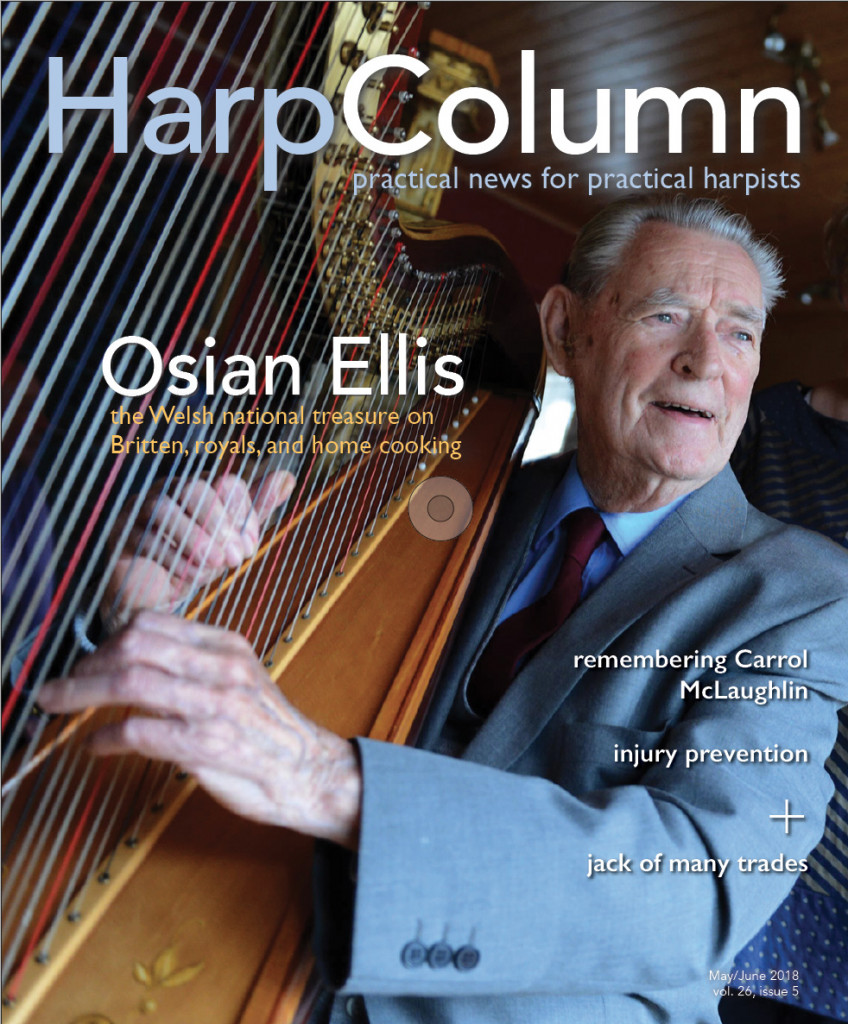Osian Ellis recently marked his 90th birthday, and he was aided in the celebration by scores of well-wishers. He was not just cheered for living nine fruitful decades, which is certainly reason enough to be lauded, but also for his profound musical contributions to his homeland and beyond. Ellis, a national treasure in Wales and a living legend in the harp world, was honored with a concert dedicated to him at the 4th International Welsh Harp Festival last month in Caerarfon. Elinor Bennett, the Festival’s organizer, was a student of Ellis’ and wanted to pay tribute to his immense musical achievements.
Ellis was principal harpist with the London Symphony for much of his career. For 30 years he taught at his alma mater, the Royal Academy of Music in London, where he succeeded his teacher, Gwendolen Mason. It was his close association with composer Benjamin Britten, though, for which Ellis is probably best known. He met the British composer in 1960, and their friendship spawned some of Britten’s most notable contributions to the harp repertoire. Britten had Ellis in mind when he wrote the harp parts for several major works, including A Midsummer Night’s Dream, the War Requiem, and the Church Parables. Britten wrote his famous Suite for Harp for Ellis in 1969. Ellis and Britten collaborated with famed tenor Peter Pears during the 1970s. Britten wrote several iconic works for the duo, including Canticle V, The Death of St. Narcissus, The Birthday Hansel, and Eight Folk Songs.
After taking a 15-year break from the harp to care for his ailing wife, Ellis is back at his beloved instrument. Now in his tenth decade, Ellis generously shared with us some nuggets of his musical wisdom and stories from his colorful career.
Harp Column: Let’s start with our lightening round of questions to warm up: What’s the coldest church you’ve ever played in?
Osian Ellis: Coldest church? Canterbury Cathedral for a performance of one of the church operas. I spent the next two or three days in bed with a bad cold.
HC: What is your favorite movement in A Ceremony of Carols?
OE: My favorite part in A Ceremony of Carols has to be the “Interlude,” where I can create my own atmosphere and react to Britten’s music.
HC: In Britten’s Young Person’s Guide to the Orchestra cadenza, do you alternate right and left hand chords or split between the hands?
OE: I always use two hands for these chords; two fingers in the right hand, and two fingers of the left hand for the lower notes. The attack is much stronger this way. Alternate hands don’t really work—they are much weaker—and a cadenza calls for a virtuoso sound. The other night I woke up and suddenly recalled that I really played those chords in D-flat major with thumb and first finger in the right hand, and the same in the left. It was a useful custom of mine to practice at night. In my mind, it sometimes avoided sore fingers! I’m sure that Britten used to compose in his head at night.
HC: For A Birthday Hansel, written for the Queen’s Silver Jubilee, did you have to practice the bowing to meet the Queen?
OE: Musicians are used to bowing to their audiences all their lives, so we are well practiced even when meeting the Queen. I have often played for her—at Buckingham Palace, at Sandringham, at the Windsor Castle and, more often, at the Royal Lodge, Windsor when her mother, Queen Elizabeth—the Queen Mother as she was known—lived there. I would meet the guests for afternoon tea about 4 p.m., and then give an informal recital about 6 p.m., sometimes with famous actors declaiming poetry, etc. On another occasion she attended a special service at Westminster Abbey in November 1988 to commemorate the first full translation of the Bible into Welsh in 1588 by Bishop William Morgan and to celebrate a new version in November 1988. The Queen afterwards wrote to the Archbishop of Wales that same day and thanked him for the service, and she further remarked: “It was a privilege to hear Osian Ellis sing his setting of Bishop Morgan’s Elegy.”
By the Way, the Birthday Hansel was written by Benjamin Britten as a tribute to Queen Elizabeth, the Queen Mother, on her 75th birthday in 1975. Because she had Scottish blood and spent much of her childhood in Scotland, he used the poems of the Scottish poet Robert Burns. The word “hansel” means a gift. It wasn’t until the following January that we performed the Hansel for the Queen and Queen Mother, and that was at her Sandringham home. She, the Queen, was out riding that morning, but she parked her horse outside the front door and came to listen to us in her riding breeches. After opening with a song or two by Purcell we performed The Birthday Hansel, then she thanked us and chatted briefly before returning to her patient horse. We then continued with a lovely lunch with the Queen Mother and a small party of royals, including Princess Margaret, the Queen’s sister.
HC: Did you use a page turner for the spinning chorus in Rape of Lucretia?
OE: I did not use a page turner for the spinning chorus in Lucretia; I think we must have spread the harp part over three pages. I remember it was quite difficult. This was written before my time with Britten. The harpist then was Enid Simon, whom I never met; she was known for smoking a pipe in public.
HC: Britten’s Albert Herring—such a fun harp part. Whose idea was it to start the fugue with the harp?
OE: Albert Herring was written before my time with Britten, but I played it at Aldebugh and at the Edinburgh Festivals, and recorded it with Britten conducting.
HC: What’s your preference: bangers and mash or kidney pie?
OE: Bangers and mash or kidney pie? Not for me! Small fillet steak with sauce Bearnaise, perhaps, or Welsh roast lamb and mint sauce. I have, myself, always enjoyed cooking.
HC: Football or rugby?
OE: Football or rugby are not on my menu either, although, while I was at school I played goal for our school team for four years, from age 13 to 17. I was even invited for a test-match to play for Wales’ Schoolboys, but on the day of the test I went down with a vicious hayfever, which I had never before experienced, nor ever since! I suspect that the good Lord was warning me to give up rough games and to concentrate on music and to keep my fingers clean.
HC: We have a couple of burning questions from some harp students about A Ceremony of Carols. First question: “Should all the tremolos in ‘Freezing Winter,’ go up? Or should they only go up in the first line, as indicated. It is written to tremolo down by the second line, it’s just more difficult to produce volume and endurance.”
OE: For “In Freezing Winter Night,” I play all the tremolos up. Play them as you find comfortable.
HC: Second question: “In the ‘Interlude,’ page two, line three—is the ‘a tempo’ the tempo from the beginning of the piece, or the slower tempo from the previous line?”
OE: The “a tempo” indicates the same tempo as at the beginning.
HC: Okay, let’s talk in a little more depth about your storied career. You’ve been called “the Queen’s harpist.” How did that moniker come about? How do you feel about that title?
OE: There were attempts during the ’60s to resuscitate this name which I discouraged as I thought that by then this function was obsolete. Further, one might be expected to play at functions and receptions, which is not, as we say, my cup of tea.
HC: We’ve read that you used to throw in your own solos when playing principal harp with the London Symphony. Is that true? Any improvisations you felt were particularly good?
OE: I think this refers to one particular performance at the Edinburgh festival soon after I joined the orchestra (perhaps 1961) under the baton of Leopold Stokowski. There was a harp cadenza in The Mephisto Waltz, if I recall correctly, by Franz Liszt. At rehearsal Stokowski encouraged me to improvise and extend the harp cadenza near the end of the work, and, of course, I obliged. One music critic observed: “The harp cadenza fell from Osian Ellis’ harp like ripe plums.” During the interval I was directed to see the maestro, who was obviously much pleased, and he declared, “Would you like to travel?” I replied “No; I do enough traveling on my own account.” He was, I think, trying to persuade me to join him in the U.S.A.
My own solos—some of my fellows might have spoken about my version of the harp cadenza in the Nutcracker Suite of Tchaikovsky where, only in rehearsals, I would fly through several keys before landing on my final chord—a squelchy jazz 15th at the end. I played it once only in public–at an open-air concert in south London.
HC: You’ve had an interesting career that consisted both of orchestral work and solo playing. Have you enjoyed one more than the other? Do they compliment each other or compete for a musician’s focus?
OE: I’m sure that both complement each other: the orchestral work allows one greater musical experience with larger canvasses. What is more important still is the value of chamber music where the harpist has to work intimately with others. I am convinced that my experience of working with a small group of players from 1954 onwards—with the Melos Ensemble, and with the Lincoln Center Chamber Music Society in New York during the 70s and 80s—widened my musical horizons enormously. But it was revelation to play in the orchestra the Mahler Second Symphony—for example, and Stravinsky’s Symphony in Three Movements.
HC: What do you love about being a musician, or a harpist, in particular? Anything that drives you crazy about it?
OE: I was born and brought up in Wales where music and musicians are commonplace – and even harpists! My school colleagues admired my football prowess more than my harping, but I wasn’t considered odd.
HC: You are so closely associated with Benjamin Britten—tell us how you two first started working together. What was your relationship like over the years?
OE: Oh dear! I could write pages upon pages about him. I met him first after a performance of the Ceremony at Westminster R.C. Cathedral in London where he had come to listen to the splendid boys’ choir under George Malcolm and for whom he wanted to write a new work; and the delightful Missa Brevis appeared in due course. We met after the performance in the Archbishop’s Room (the newly appointed Cardinal Godfrey) where young priests served us with delicious drinks.
He invited me to play at his Festival at Aldeburgh (pronounced “Ald-boro”—on the River Alde). Later, he wrote to me to say that he was writing for two harps in his new opera, A Midsummernight’s Dream, and would I like to invite another harpist to join me. So I invited a young man who had recently retired from the BBC Concert Orchestra; I knew that he had not been well and I thought we might give him a lift. I brought an extra harp with me for his use and we started rehearsing the opera with Britten. However, he would occasionally stop playing while I would try to egg him on. I then arranged with him to have a rehearsal together, but he did not turn up. I then looked at both parts and came to the conclusion that I might be able to play them on one instrument. Britten was sympathetic to our plight (some conductors I knew would have thrown an explosive tantrum), and we spent all the afternoon copying the two harp parts into one with the help of Imogen Holst and Rosamund Strode—both were music assistants to Britten at that time, and I played the new harp part that evening in the dress rehearsal with the ink not quite dry! (We learned later that my harp colleague was suffering from a form of schizophrenia – poor dab!) And for that season we used just the one harp; but when we came to record the opera—this time with the LSO—we reverted to the two harps. Britten’s tolerance of this situation illustrates his compassion for those in distress. He knew and called all his players by their first names, and we all called him Ben. He even remembered the names of our wives!
At his 50th birthday celebration concert in 1963 he approached me quietly and said he was writing a new opera for church performance with just six or seven instrumentalists: he would like to include a harp in the group, but only if I were willing to take part. What could I say? I could not refuse, and the opera “Curlew River” appeared in 1964 and two more in 1966 and 1968. Fortunately, we arranged deputies to take over in case of accidents or illness—as was the custom with the singers. There was no conductor in these performances, so we had to know the music very well. The only time that Britten ever consulted me about harp writing was during the composition of the second of this trilogy, The Burning Fiery Furnace about King Nebuchadnezzar; he wanted to write a procession for us where I would carry a little Irish harp and play a dotty little tune in D-flat but with a D natural next to middle C. He wrote me a letter (though he was bedridden at the time) illustrating in rough manuscript the small repetitive passage. And, of course, it worked perfectly. In procession one had to hold the harp with the left hand and play the notes with the right hand only—which Britten had already realized. In the third Church Parable—as Britten liked to call them, “The Prodigal Son”—he wanted me to slide the pedal up and down, glissando-like, while accompanying the devilish Tempter who coaxes the prodigal son to do naughty things. During rehearsals we spent some time on these pedal-glisses to make them more apparent and effective; thus, it was spread around, Benjamin Britten was seen giving me harp lessons.
HC: Britten’s Suite for Harp is a gem of the harp literature. What are your thoughts on the piece?
OE: Britten invited me to give a harp recital at his Aldeburgh Festival in 1969. I was to choose the program and the other artists to join me, and with a twinkle in his eye he added: “You can commission a new work for the harp from any composer you care to mention.” I did not need to be told twice, and not long afterwards the Harp Suite in C Major arrived by post. Three days later, after a rehearsal of the War Requiem, I asked Ben, as we all called him, “Would you like to hear the Harp Suite?” At the end he was thrilled to bits and purring like a cat. What pleased him most, I think, was that the piece worked— he was a craftsman as well as a composer. He changed a little at the bottom line of the first page, “Ah, that’s piano writing—how silly of me.” The next morning at the full rehearsal of the War Requiem, he brought with him a slip of MSS with the small alteration. He also asked during our run-through, “Could you damp the lower strings of the harp at the beginning of the ‘Fugue?’ The undertones blur the clarity of the ‘Fugue.’” “Easy,” I replied. So I placed some damping signs below the bass clef. (Curiously, some harpists thought they had to damp the notes they were playing, which made it sound like Mickey Mouse music.) The last movement [of the Suite] is based on an old Welsh hymn tune called “St. Denio,” of which he just takes a fragment and makes several variants culminating in a celebratory climax before melting slowly into silence. When I introduce the Harp Suite to an audience, I often declare that Benjamin Britten is one of the few contemporary composers who can still write in C major.
HC: What do you think is the most difficult harp part Britten ever wrote?
OE: You ask about the difficulty of Britten’s harp parts. They are only sometimes difficult, but they become straightforward with longer acquaintance, and, of course, hard practicing.
HC: In addition to Britten, many composers—including Mathias, Menotti, Alwyn, and many others—have written music for you as a soloist, chamber musician, and for your duo with tenor Peter Pears. What are some of your favorite works among these?
OE: Menotti’s Quintet for Harp and String Quartet was written for a commission from Miss Alice Tully after I performed at Menotti’s Spoleto Festival in Italy in July, 1976. The quintet was to be performed with the New York Chamber Music Society the following April [1977]. I contacted [Menotti] around Christmas, but he had not yet begun. In the meantime I saw he was producing operas in Paris—Debussy’s Pelleas—and later in London. Eventually the piece arrived bit by bit, and a small cadenza on the morning before I was flying to New York. Unfortunately, the piece was for string quartet with harp, while Alice Tully and I had hoped for a virtuoso composition similar to Ravel’s Introduction & Allegro. I gave only that single performance, but I heard that it was later used for ballet performances. We met to rehearse the Quintet in New York at the apartment of the baritone and a kind friend, Theodore Uppman, and we had the great composer Samuel Barber in attendance—a lifetime colleague of Menotti. I gently suggested to Barber that he might like to write a work for the harp, but alas, he rejected, with apologies, the proposition.
The Danish composer, Jorgen Jersild (1913-2004) (pronounced Yor-en Yer-sild), wrote several pieces for me, including a harp concerto, which I played many times in Europe and at the Aldeburgh Festival in 1972. He was at home with the harp, for his daughter, Lena, played the instrument. I first played his quartet for flute, clarinet, cello, and harp, and then he wrote several solo pieces and a duo. They are published by Hansen, Copenhagen, and are also found on Danish Records.
The harp concerto, Lyra Angelica, (1954) by William Alwyn (1905-1985) was not written for me—it was first performed by Sidonie Goossens and the BBC Symphony Orchestra. I had played many times for Alwyn while recording his film music, and one day he asked me to come to his home to play his harp concerto. After the playthrough he appeared excited as he told his wife Doreen Carwithen, a composer in her own right, “Do you know, he never asked me to change a single note!” Apparently another harpist wanted to make changes, which obviously did not please him. I then performed the work with him and the London Philharmonic Orchestra at London’s Festival Hall, and later we recorded the work.
HC: What are some of your favorite memories from your orchestral career?
OE: Before I became a member of the London Symphony Orchestra in 1960, I often appeared with the Philharmonia Orchestra. It’s mostly a recording orchestra, with conductors like Herbert von Karajan, whose recording of Der Rosenkavalier was memorable. We also made a tour of U.S.A. with him in 1955. I found him accommodating, which I cannot say for Guifdo Cantelli, a protegé of Toscanini, who was brilliant but very severe and rather frightening. The LSO was more relaxed, especially under the mellowed Maitre Pierre Monteux who had 60 years of experience of conducting Debussy, Ravel, and Stravinsky. I recall the orchestra playing The Rite of Spring at the Royal Albert Hall in 1963—50 years after its first performance in Paris. During the applause, who should appear in a box seat unknown to us or to Monteux, but Stravinsky himself with the spotlights illuminating him. The packed audience went into a frenzy, and Monteux stepped off the stage to climb the steps to the box to join him. I was sitting next to Mme. Monteux (there is no harp in the Rite), and she urged me to follow [Maestro Monteux] lest he fall in his haste—he was about 83 then. I could hardly keep up with him in his excitement.
It was also a memorable occasion when I played the Debussy Danses with Monteux. At rehearsal he told me he had conducted the first performance in Paris in 1904; “But the ‘arp was not very good!” This I could believe, for it was the new-fangled cross-stringed harp invented by Pleyel. (Sorry if I offend anybody!) I suggested to him that I liked to play the opening without arpeggios—plaqué—and he insisted that was exactly right. There is a similar passage in the later Le Martyre de St Sebastien for orchestra, which has a similar theme with a “church-like” atmosphere. We performed the Debussy Danses in London, Paris, and Vienna. [Conductor] Herbert von Karajan was in the audience in Vienna, and observed that he often played the Dances in the two-piano version in his younger days. •
Special thanks to Elinor Bennett for assistance in coordinating this interview, and to Lynne Aspnes and the students of Joan Holland in crafting some of the questions.






